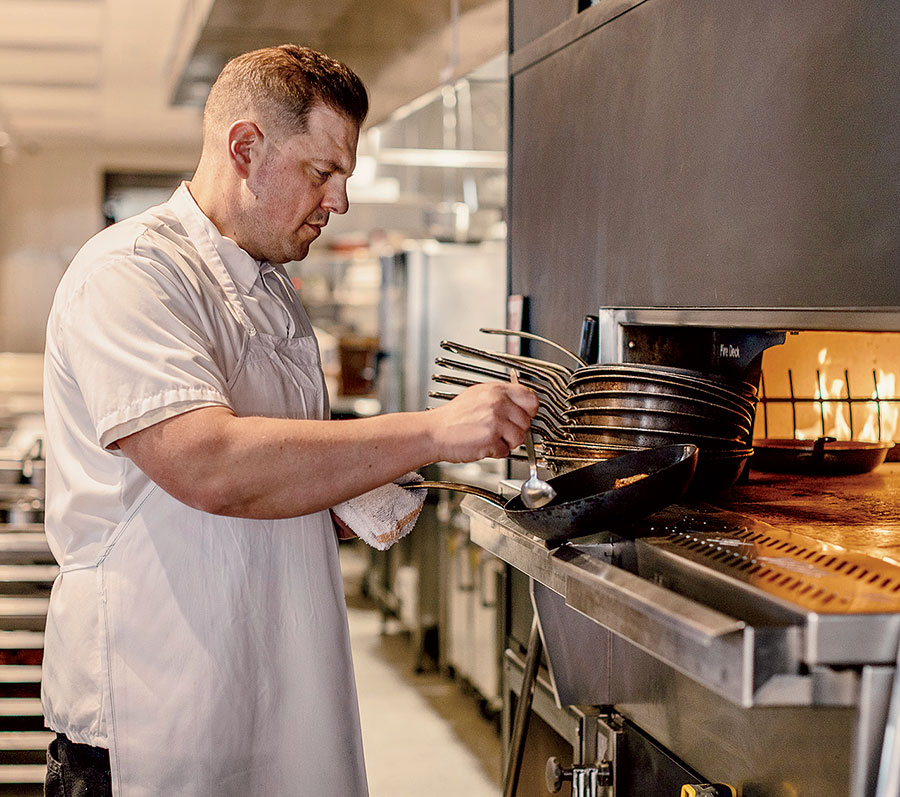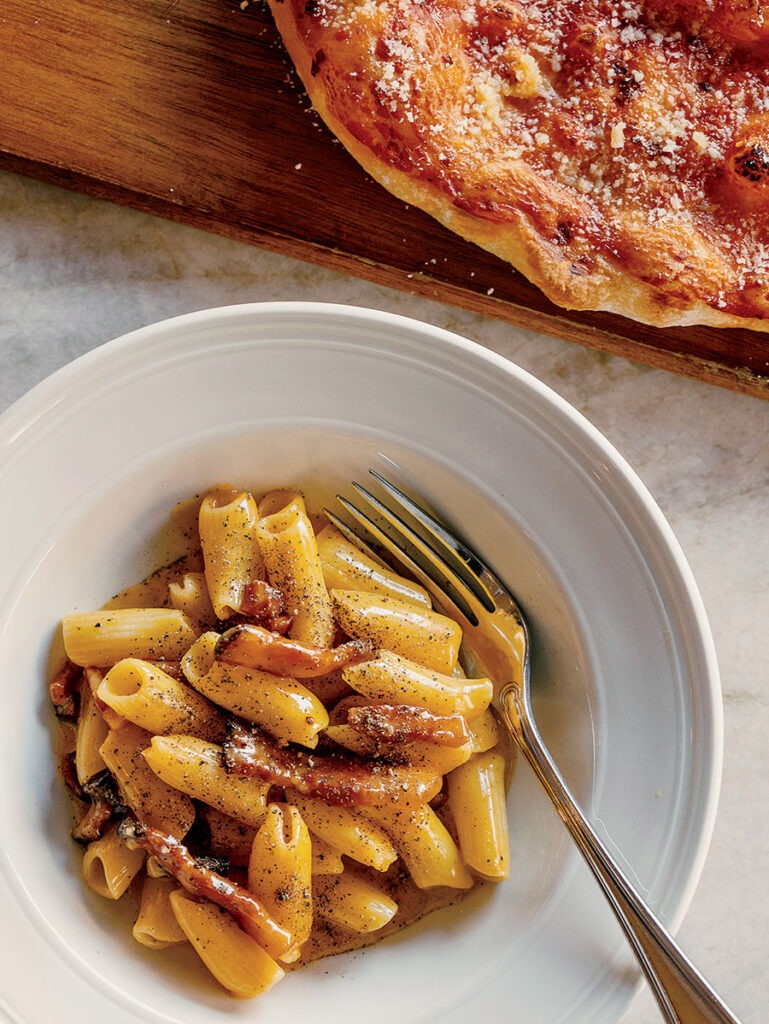If you order the rigatoni alla amatriciana at Il Carciofo, the cook starts with a handful of diced guanciale, cured pork jowl that looks like bacon but has a far denser texture. Over a flame it renders quickly — the fat liquefies while the flesh shrinks into porky pebbles. The cook tips white wine into the pan, and as it all simmers, the guanciale turns toothsome. Tomato purée goes in next, along with a pinch of red pepper, a splash of cooking water, and the rigatoni. It all comes together in a glossy, depth-charged sauce that doesn’t so much coat the pasta as meld with it. The dish is a triumph.
This is the kind of cooking Il Carciofo’s chef-owner, Joe Flamm, does so well. He takes a familiar — even overplayed — recipe, then shows you what it can and should be. I’m assuming you know Flamm. If you’ve managed to secure a reservation here, you’re surely a fan. You watched this big, blue-eyed 38-year-old with his boyish face and familiar South Side accent lose on Top Chef only to come back through a Last Chance Kitchen challenge to vanquish every other contestant and take home the trophy. Perhaps you loved him at Spiaggia, where he served as Tony Mantuano’s executive chef, or you lined up early at Rose Mary, his first West Loop restaurant, to snag a bar seat as soon as the doors opened. Flamm earned his fame first by being a manifestly genuine person and then by rewarding his admirers with real food prepared with care.
While Rose Mary focused on the Adriatic fare of eastern Italy and Croatia, Il Carciofo explores the traditions of Roman trattorias. This style offers many familiar reference points, from cacio e pepe to the fried artichokes that give this restaurant its name. I find it an easy restaurant to like and one that I may learn to love once it finds its groove. Because so much of the food comes together à la minute, the kitchen team needs to figure out timing so that every plate goes out as baller as that rigatoni. Likewise, the front of the house has to learn to work this rugby pitch of a room, which has a dining bar, a bar bar, and an always-in-use private room. Il Carciofo has been packed from day one, so expect service that’s friendly, if mechanical, and occasionally out of sync.

The staff offers one boss move that I wish more restaurants would adopt: The reserved table is yours as soon as the first guest arrives — no squishing into the front vestibule waiting for “all members of your party.” Not to humblebrag, but I got there first once and had time to admire this boisterous space with its open kitchen extending the length of the back wall. When I wandered toward the back looking for the restroom, I passed the now de rigueur Italian restaurant design flourish: a glass-walled pasta lab. The vibe isn’t homey trattoria as much as Chicago glam, but that’s OK. That’s why we come to the West Loop.
Arriving early also allowed me time with beverage director Kyle Davidson’s drinks list. The cocktail menu is divided into aperitivi (refreshing drinks to enjoy before dinner, such as spritzes), misti (mixed drinks like a rose cardamom Collins that gets a tang from grappa), and digestivi (strong potions best sipped after the meal). Here you’ll find one of Davidson’s signatures, the Art of Choke, which he first devised for the Violet Hour nearly two decades ago. It involves rum, green Chartreuse, lime, and the artichoke amaro Cynar. Talk about on brand.
I’m thrilled with the variety of lambruscos (chillable sparkling reds, both sweet and dry) the menu proposes. The pale Paltrinieri Radice is like drinking rhubarb, and it loves all the appetizers we’re passing around the table: fingers of fried salt cod clad in jackets of crunchy batter with lemon aïoli; slips of swordfish crudo with fennel and orange; and fried rice balls (suppli) oozing beef ragu and mozzarella.
In some cases I found myself liking a dish but wanting more oomph, like the signature carciofi alla giudia, deep-fried artichokes named for their origin in Rome’s Jewish quarter. The kitchen did a decent job with the frying, getting the leaves as brittle as phyllo while keeping the heart creamy, but they just didn’t give good in-season artichoke. Where did Flamm source this spring vegetable in the middle of winter? From Italy, he says, which may be why two small specimens cost $14.

Standout dishes, though, elevate every meal here. For us, those were a spinach and ricotta ravioli better than any in memory and a duo of roast pork belly and loin, the latter draped in so much brilliant salsa verde that I kept looking for the phantom bread basket. Next time I’ll order it alongside the Roman-style rosso pizza, a crispy and airy oblong thing painted with sauce and dusted with Parm.
Yet for every liftoff, there’s a return to earth. The only salad on the menu, a Tuscan kale number, was there for the folks who gotta have a Caesar, while lamb ribs in vin santo would’ve satisfied more had one not been a bone with barely any meat. A tagliatelle in a watery oxtail tomato sauce was intriguing initially but ultimately a snooze.
Flamm implored me to try that dish again because it’s one of the restaurant’s signatures, the only representative of Rome’s quinto quarto cooking. The ‘fifth quarter’ is offal and lesser cuts of meat, which Romans have turned into a variety of iconic dishes. Perhaps a couple more of these might help Il Carciofo separate itself from all those other places with $24 carbonara.
So unless you’re a Flamm superfan, give Il Carciofo time for the crowds to abate. Then go, order something you know you like, and wait for that moment, that bite, that makes you stop to take notice and ask yourself: Is this the best version I’ve ever had? Yes it is.



